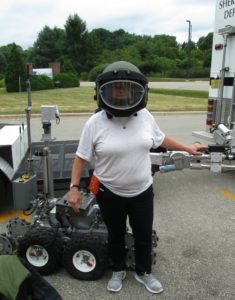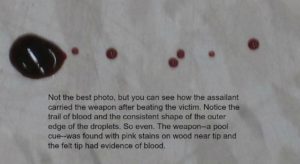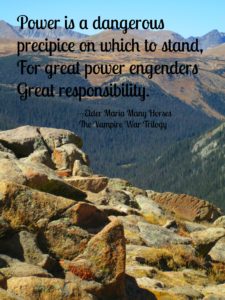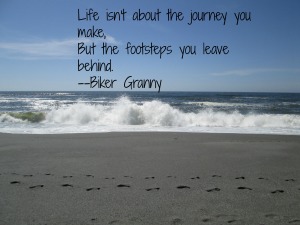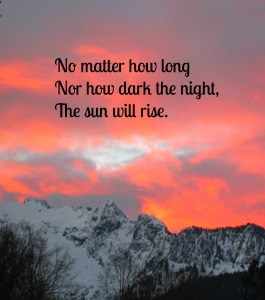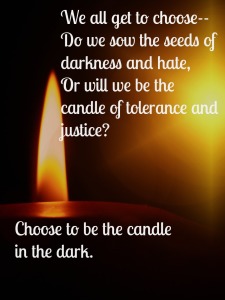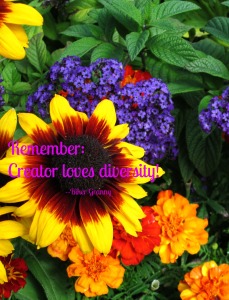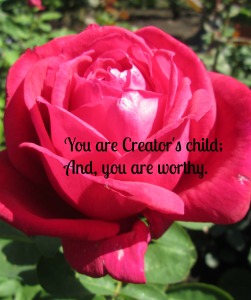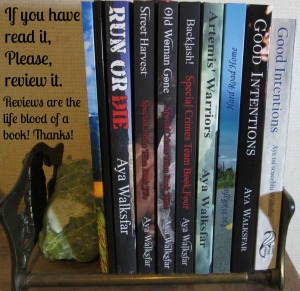Lieutenant Chris Knurr took on the scary (nearly as scary as disarming bombs!)task of teaching a roomful of writers about things that go boom.
Here is the brave individual! 
I’m not real sure that he should have told us about Macgyver bombs, though. Those are things of which nightmares are made. These little explosive devices are also called acid bombs or bottle bombs. And, they are one of the scariest bombs out there. Why? Not because they are the most destructive–not even close. What’s so scary is that these highly unstable and unpredictable bombs can be made from readily available supplies found in many homes! Chris showed us a short video clip of one young man who put the chemicals for the bomb in a plastic bottle and then shook the bottle. The bomb exploded in his hand. Though these are not even close to the most destructive explosives, they can still maim and kill.
Sometimes, I get so wrapped up in thinking about the explosives used to create bombs–things like dynamite and C-4–that I, like many others, are unaware of the danger present in those small or long, thin devices called detonators. Chris passed a non-el or shock tube around so that everyone in the room was holding it and then he set it off. It was startling with a small zap, but if it had been part of a bomb it would have been used to initiate a detonator or blasting cap.(please note: things in bold are corrections made to original post per information from Lieutenant Knurr. Thank you, Lieutenant Knurr, for passing along these clarifications! You rock!)
Det cord is a high explosive wrapped in a plastic coating, needing a detonator or blasting cap to initiate it. When it is set off by a blasting cap, it sends a detonating wave to other blasting caps or explosive charges. This cord is commonly used to connect explosives together.
After that fairly benign demo of a shock tube, he passed around inert blasting caps—little metal tubes not more than a couple of inches long and smaller in diameter than my little finger. Though they look harmless, they are small, sensitive primary explosive–woe be to those who forget this part of the description–devices used to detonate a larger, more powerful and less sensitive secondary explosive such as TNT, dynamite or plastic explosives.
One man did forget the description of blasting caps. Chris showed us a photo of what was left of the man’s face after he bit down on a live blasting cap. We could just about make out his eyes above the ruin of his face. Nose, lips, mouth, cheeks, and chin were gone. Blood was streaming down the red mass that had been his face. It was nothing short of a miracle that the man survived.
Since I am writing a thriller where homemade explosives play a significant part, I was especially interested in the part of the lecture dealing with ANFO, or bombs made from ammonium nitrate and fuel oil. Several thousand pounds of a slightly different formulation of this type of explosive–ANNM which is ammonium nitrate with nitro methane fuel–was packed in the vehicle that Timothy McVeigh parked in front of the Alfred P. Murrah Federal Building on April 19,1995. He lit a two minute fuse and when the explosion occurred it killed 168 people, including 19 children and injured another 684 others.
Two of the most popular, homemade high explosives currently seem to be TATP and HMTD, both hydrogen peroxide based. Chemicals to make these bombs are fairly common. Unfortunately for law enforcement, the labs producing these high explosives may appear to be meth labs since TATP is a white crystal and HMTD is a white powder. These explosives are unstable.
Chris’ lecture covered many other types of explosives as well as such topics as what defines the ‘explosive train’, but those things would require a lot longer post and much more skill to explain than I have to make it as understandable as Chris did for us. (Just because I could understand it, doesn’t mean I can explain it! Chris is a talented teacher and an accomplished expert in all things that go BOOM!)
There were some things that really snagged my attention, though.
- I had no idea that a suitcase full of firecrackers, if set on fire, could blow up a full size car!
- Car bombs in a downtown area is a bomb squad’s nightmare.
- It is way too easy to buy the ingredients to create a bomb! Scary!
- There are 2700 civilian bomb techs trained by the FBI.
- A “dirty bomb” is not one that needs a bath; it is an explosive that has radioactive material on it.
- Grenades, and high explosives, create pressure waves/shock waves that go through a body. This, in turn, creates fluid waves (we are mostly water) that shred the inside of the body. This is what kills.
- The bomb suit—Explosive Ordnance Disposal suit (EOD)–weighs over 80 pounds and someone has to wear it! It is hard to move in it and is very hot! (I tried on the helmet and the coat part. Do you remember what it felt like when you were a little kid and your mom bundled you up for cold weather and you could barely move? Yup, a lot like that.)The helmet weighs about 8 to 10 pouunds. The bomb suit, in order to maximize dexterity and mobility, has no gloves. This leaves hands and forearms exposed to danger.

(This photo is used courtesy of Tom Middleton)
EOD technicians wear the suit during reconnaissance, when trying to ‘render safe’, or disruption procedures on potential or confirmed explosive devices. These suits protect the wearer from fragmentation, blast overpressure, thermal and tertiary effects should the device explode. An interesting note: technicians back away from explosive devices not because they are “afraid” of the bomb, but because most of the protection resides in the front plate of the suit.
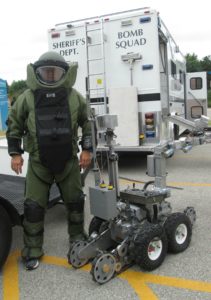
Tom Middleton models the EOD suit next to the robot used by the bomb squad.
Though I have only been able to grasp a mere fraction of the information he conveyed, Chris gave me something more valuable even than knowledge of explosives; he gave me a better understanding of the dangers faced from international and homegrown terrorists who have easy access to the information and ingredients to create explosive devices; and he gave me a better understanding of the pressures the people of a bomb squad face as they work to protect the public.
